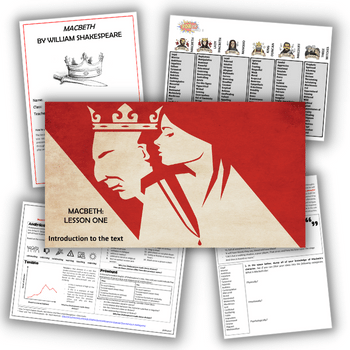5 ways to teach Macbeth better

Give your English literature GCSE students the best chance of success when tackling the Scottish play, with Charlotte Bourne’s active approaches…

1 | Explore performance
Performing the text allows students to find their own voice within Shakespeare’s language. However, it can be intimidating if they think there is a ‘right’ way to do this.
One way to overcome learners’ inhibitions is to show multiple interpretations (ie there are many ‘right’ ways).
Begin by having students analyse how different Macbeth actors have communicated with the audience using body language, facial expression and other movements.
Getting pupils comfortable with this will give the performance activities below greater validity.
2 | Feel the rhythm
Rhythm shapes the way we hear and therefore understand language: ‘we stress the words we want the world to hear.’
To consolidate this, have students create their own lines of iambic pentameter; which words do they want the world to hear?
Apply this by reading and ‘heartbeating’ (da-DUM on the chest) Macbeth’s ‘I dare do all that may become a man.’ What impression does this create? How has iambic pentameter shaped this?
However, students need to place lines in the wider context of the scene to fully understand how iambic pentameter shapes meaning. Once students are attuned to its pattern, they will notice where Shakespeare changes it.
In pairs, have them read and ‘heartbeat’ the exchange between the Macbeths in A1S7, noting what happens to the line patterns. Too short? Too long? Interrupted – or completed – by another?
Any disturbance in the line’s ‘heartbeat’ should prompt the question: why? Thus, when asked, ‘What impression do you have of the Macbeths’ relationship in A1S7?’, students should be able to meaningfully analyse how verse structure contributes to this impression.
3 | Physicalise characters
It is difficult to understand how Macbeth could contemplate regicide in A1S3, but students need to in order to grasp the central dichotomy of the play.
Have students physicalise Macbeth’s thoughts by walking slowly around the room as they read his asides from line 135 onwards.
Each time they reach a punctuation mark, they should change direction. This helps them feel the contradictions in Macbeth’s mind as he contemplates regicide.
Furthermore, in undertaking a personal exploration of the text (individual, active reading) but in a social space (the classroom), they can also feel the complexities of navigating (literally) the private/public divide.
As such, they have the chance to feel Macbeth’s personal ambition at odds with the belief in the Divine Right of Kings.
To develop personal responses that foreground this relationship between character and language, probe with: ‘What impression do you have of Macbeth’s character? How has Shakespeare created this?’
4 | Track themes
Have students track a theme across the play, looking for evidence of where it occurs. For the theme of power, for example, students might identify Lady Macbeth’s A1S5 soliloquy (lines 39-55) as evidence.
Once they have done this, they should explore how that theme is established through Shakespeare’s language. For this soliloquy, have students work in pairs: one reading, one listening.
The listener should repeat any words from the speech that link to ‘power’; you can scaffold by giving time beforehand for underlining, or by giving categories (imperatives; images of obscurity).
Ask the ‘echoes’ how this language felt: powerful? Desperate? Subversive? Exploring why can lead to interesting contextual observations. You could further this by having them compare her language in A5S1.
5 | Remember context
Students must integrate context and meaning: our interpretation of the text’s themes is shaped by our own context. Look at which themes are made most relevant by our context; in Macbeth we have ambition, power, how/if gender should be defined, fear of women…
When looking at Lady Macbeth as a powerful woman, students should consider power as well as womanhood. What does it mean to us to be ‘weak’ – what did it mean to a contemporary audience? Why might it differ? What is the relationship between weakness and womanhood?
Have your students style a reading to emphasise Lady Macbeth’s vulnerability or her viciousness, and follow this with a discussion around which contexts might fit each interpretation.
Want more of these approaches? Visit teach.shakespearesglobe.com/ks45-macbeth-text-performance.
Shakespeare’s Globe GCSE Study Days are packed with even more active approaches, underpinned by the intellectual rigour of the AOs and the experience of its unique performance conditions: shakespearesglobe.com/education/teachers/at-the-globe/key-stage-4.
Charlotte Bourne is deputy head of learning at Shakespeare’s Globe, a qualified English teacher, an AQA examiner and has an MA in education. Download our AQA English Literature Paper 1 – Macbeth/Christmas Carol walkthrough and join us as we analyse 7 of Banquo’s quotes.








